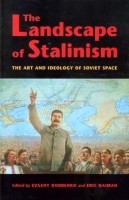categories
- Traffic and Vehicles Catalogue
- socreal.catalog
- Advertisement Catalogue
- Photo Catalogue
- Chinese and Japanese Catalogue
- New Holy Card Catalogue II.
- 12 interesting old books
 Books
Books
 Bibliophil
Bibliophil
 Antiques
Antiques
 Engraving
Engraving
 Maps
Maps
 Photos
Photos
 Antique Papers, Small Prints
Antique Papers, Small Prints
 Posters
Posters
- Circus
- Modern Graphics
- Socialist Realism
- NER Propaganda
- Others
cart
Cart is empty
You've not logged in
Dobrenko, Evgeny - Naiman, Eric (Ed.) : The Landscape Of Stalinism. The Art and Ideology of Soviet Space
- description
- additional information
Studies In Modernity and National Identity.
This wide-ranging cultural history explores the expression of Bolshevik Party ideology through the lens of landscape, or, more broadly, space. Portrayed in visual images and words, the landscape played a vital role in expressing and promoting ideology in the former Soviet Union during the Stalin years, especially in the 1930s. At the time, the iconoclasm of the immediate post-revolutionary years had given way to nation building and a conscious attempt to create a new Soviet 'culture'. In painting, architecture, literature, cinema, and song, images of landscape were enlisted to help mould the masses into joyful, hardworking citizens of a state with a radiant, utopian future - all under the fatherly guidance of Joseph Stalin.From backgrounds in history, art history, literary studies, and philosophy, the contributors show how Soviet space was sanctified, coded, and 'sold' as an ideological product. They explore the ways in which producers of various art forms used space to express what Katerina Clark calls 'a cartography of power' - an organization of the entire country into 'a hierarchy of spheres of relative sacredness', with Moscow at the centre. The theme of centre versus periphery figures prominently in many of the essays, and the periphery is shown often to be paradoxically central.Examining representations of space in objects as diverse as postage stamps, a hikers' magazine, advertisements, and the Soviet musical, the authors show how cultural producers attempted to naturalize ideological space, to make it an unquestioned part of the worldview. Whether focusing on the new or the centuries-old, whether exploring a built cityscape, a film documentary, or the painting Stalin and Voroshilov in the Kremlin, the authors offer a consistently fascinating journey through the landscape of the Soviet ideological imagination. Evgeny Dobrenko is a lecturer in Slavic studies at the University of Nottingham, England. Eric Naiman is associate professor of Slavic languages and literatures at the University of California, Berkeley. The other contributors are Oksana Bulgakowa, Katerina Clark, Randi Cox, Mikhail Epstein, Boris Groys, Hans Gunther, John McCannon, Jan Plampe.
This wide-ranging cultural history explores the expression of Bolshevik Party ideology through the lens of landscape, or, more broadly, space. Portrayed in visual images and words, the landscape played a vital role in expressing and promoting ideology in the former Soviet Union during the Stalin years, especially in the 1930s. At the time, the iconoclasm of the immediate post-revolutionary years had given way to nation building and a conscious attempt to create a new Soviet 'culture'. In painting, architecture, literature, cinema, and song, images of landscape were enlisted to help mould the masses into joyful, hardworking citizens of a state with a radiant, utopian future - all under the fatherly guidance of Joseph Stalin.From backgrounds in history, art history, literary studies, and philosophy, the contributors show how Soviet space was sanctified, coded, and 'sold' as an ideological product. They explore the ways in which producers of various art forms used space to express what Katerina Clark calls 'a cartography of power' - an organization of the entire country into 'a hierarchy of spheres of relative sacredness', with Moscow at the centre. The theme of centre versus periphery figures prominently in many of the essays, and the periphery is shown often to be paradoxically central.Examining representations of space in objects as diverse as postage stamps, a hikers' magazine, advertisements, and the Soviet musical, the authors show how cultural producers attempted to naturalize ideological space, to make it an unquestioned part of the worldview. Whether focusing on the new or the centuries-old, whether exploring a built cityscape, a film documentary, or the painting Stalin and Voroshilov in the Kremlin, the authors offer a consistently fascinating journey through the landscape of the Soviet ideological imagination. Evgeny Dobrenko is a lecturer in Slavic studies at the University of Nottingham, England. Eric Naiman is associate professor of Slavic languages and literatures at the University of California, Berkeley. The other contributors are Oksana Bulgakowa, Katerina Clark, Randi Cox, Mikhail Epstein, Boris Groys, Hans Gunther, John McCannon, Jan Plampe.
| condition: |      |
| category: | Books > History > 20th Century, Politics > |
| category: | Socialist Realism > |
| category: | Books > Foreign Language Books > Books in English > |
| publisher: | University of Washington Press, (2003) |
| item number / ISBN: | 9780295983417 |
| binding: | paperback |
| pages: | 315 |
| language: | English |









 Telefon:
Telefon: E-mail:
E-mail:







